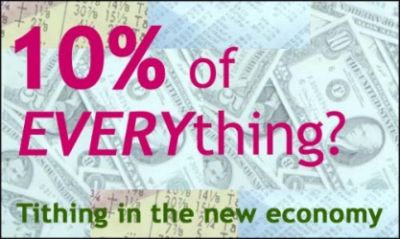The under-covered story of tithing
 Tithing in this country is a bigger story than initially meets the eye. Every local newspaper should be doing stories on tithing. It matters. Tithing in Prince George's County, Maryland, helps make it one of the top five counties in the country for charitable giving, according to a Washington Post story earlier this month. That alone is a huge story and was well-treated in a thorough report:
Tithing in this country is a bigger story than initially meets the eye. Every local newspaper should be doing stories on tithing. It matters. Tithing in Prince George's County, Maryland, helps make it one of the top five counties in the country for charitable giving, according to a Washington Post story earlier this month. That alone is a huge story and was well-treated in a thorough report:
Tithing, an ancient practice described in the Bible, is particularly strong in African American communities, where it is reinforced by centuries of family tradition. That has helped propel Prince George's into the top five counties in the nation for charitable giving, as documented by a Chronicle of Philanthropy study based on donations as a percentage of income.
A Washington Post analysis using the same data found that 14 of the top 20 Zip codes for per capita giving in the region were in Prince George's.
Across the spectrum of faiths, religious institutions draw much of the nation's charitable money, accounting for three out of every four dollars given, the chronicle's study of 2002 IRS data found. In African American communities, the figure is closer to nine out of every 10 dollars.
Tithing is clearly a huge driver behind charitable giving in the United States. According to this Beliefnet article, Americans give away an average of 3 percent of their wealth. Tithers, by definition, give more. But what kind of charity is it? Where does that money go?
Here's the Washington Post:
In Prince George's, tithing has played a major role in supporting churches -- helping provide the capital, for example, to develop the 73.8-acre campus of Jericho City of Praise, a megachurch in Landover, and pay off its mortgage in seven years.
Gone are the days when religious institutions were the center of a community's charity. That story has been written many times, but what about the stories on what churches are now doing with their time and money? I know the easy answer is that churches have been removed from their once-held prominent spot in community life, but that can't be the only answer.
To make things even more interesting, many congregants are now giving through direct deposit rather than during worship services.
A Cincinnati Enquirer article, also published earlier this month, highlights that theme quite nicely:
More than a year ago, officials at St. Catharine of Siena Catholic Church in Westwood opted not to automate collections.
"It just gives people another excuse not to attend Mass," said Ferd Schneider, the church's business manager.
Others have scriptural objections.
"Giving is an act of worship, and it's pretty hard to worship when you're not participating," said Jack Wilkerson, vice president of business and finance for the executive committee at the Southern Baptist Convention, the largest Protestant denomination in the United States.
"We believe this is about being true to Scripture and not about bringing in money,'' he said. "If Scripture meant that you should send it, it would have said send it.''
Tithing makes up a great part of American giving, as the Washington Post demonstrated. It's something that journalists should keep their eyes on, especially since it should be readily available through the Internal Revenue Service or directly from congregations.